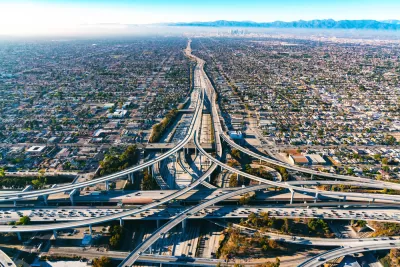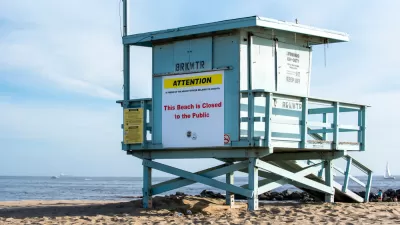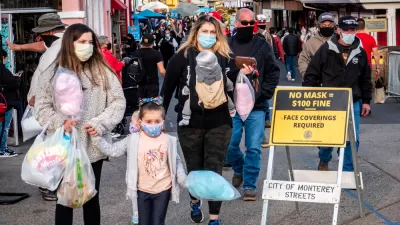COVID-19 deaths topped 5,000 in Los Angeles County last week as deaths continue to mount due to a hasty reopening after an early shutdown. The center of the of outbreak in California now shifts to the Central Valley.

Los Angeles County, the nation's most populous with over 10 million people, has long held the top left position on the Johns Hopkins "COVID-19 United States Cases by County" Coronavirus Resource Center dashboard, registering almost *221,000 cases on Aug. 15, followed by Miami-Dade, the seventh most populous, with over 144,000 cases and Maricopa (Phoenix), the fourth most populous, with almost 129,000 cases.
California leads the nation with over 622,000 total cases, followed by Florida (573,000), Texas (553,000) and New York with over 429,000, according to the New York Times coronavirus tracker on Aug. 16.
Los Angeles is now inching it's way up on the top right column, "Top 20 Counties by Number of Deaths," currently third behind Queens (5,976 deaths) and Kings (Brooklyn, 5,638 deaths) counties in New York City, the 11th and ninth most populous, respectively.
"Total deaths from COVID-19 topped 5,000 in Los Angeles County on Tuesday, in what officials are calling a 'heartbreaking' milestone for a health and economic crisis that won’t disappear anytime soon," reported Joseph Serna, Phil Willon, and Laura J. Nelson for the Los Angeles Times on Aug. 13. Johns Hopkins shows 5,246 deaths in Los Angeles County based on Aug. 15 data.
“This is heartbreaking and reminds us of the human toll of this pandemic,” said Dr. Barbara Ferrer, the county health director. “One of the [63] deaths we are reporting today is of a young adult under the age of 29. This is a reminder that the risk for all of us is real and that no matter how young you are, this virus can be deadly."
Los Angeles County, with 26% of the state's population of nearly 40 million, has the dubious distinction of having 36% of the state's coronavirus cases and 47% of state coronavirus deaths of 11,224, according to the state coronavirus dashboard based on Aug. 15 data, the third highest in the nation after New York (32,414) and New Jersey (15,912), according to the New York Times coronavirus tracker on Aug. 16.
Epicenter shifts from coastal to inland
But just as the epicenter of the pandemic in the U.S. shifted from the Northeast and Midwest to the South and West following a surge that started during the Memorial Day weekend that can be traced to the state reopenings, so too is the epicenter shifting in California.
"The Central Valley is currently the hardest-hit part of the state," add Serna, Willon, and Nelson. "Infections are spreading rapidly in Kern County, where there are now more than 1,000 cases per 100,000 residents, and Merced County...By comparison, Los Angeles County has about 340 cases per 100,000 residents."
Correspondent's note: These rates appear to be based on the last 14 days, looking at the Los Angeles Times coronavirus tracker. On a daily basis using a 7-day moving average with data based on Aug. 14, Harvard's COVID Risk Levels Dashboard (posted here) shows:
- Lassen County: 249.1 cases per 100k people [Results from "a major outbreak among inmates at a state prison in Susanville, linked to the transfer of inmates from San Quentin State Prison", as reported by LA Times on July 1.]
- Merced County: 90.8 per 100k
- Kern County: 61.6 per 100k
- Statewide: 23.5 per 100k
- Los Angeles: 20.7 per 100k
Red-zone counties or states, according to the public health experts who devised the dashboard, exist where daily case incidence levels >25 per 100k. Stay-at-home orders are recommended. Only Alpine County, population 1,129, is green in California, meaning less than 1 case per 100k, where the virus is "on track for containment."
Farm and food processing workers
The outbreak is linked to hundreds of thousands laborers in the food industry, reports Vivian Ho in a deep dive for The Guardian on Aug. 8. "In the eight counties of the San Joaquin Valley, a 27,000-square-mile area of 4.3 million residents, coronavirus cases are at 1,900 per 100,000 residents. In comparison, the San Francisco Bay Area, with 7.7 million residents in 7,000 square miles, has 770 cases per 100,000 residents."
"The surge in Central Valley cases has taken a particular toll on farmworkers, in part because they often live in close quarters, share transportation to job sites and have little access to healthcare," reported the Los Angeles Times on July 28. "Gov. Gavin Newsom said Monday that the rate of positive coronavirus tests in the Central Valley ranges from 10.7% to as high as 17.7%. The state’s average is about 7.8% over the last seven days."
Since then, the state's average test positivity rate decreased to a 7-day average of 6.9% on Aug. 15, but some Central Valley county rates have skyrocketed. According to Covid Act Now, the rates in Kings, Lassen, Yuba and Merced counties are 39.5, 33.2, 25.5 and 22.3, respectively, on Aug. 16.
Where did Los Angeles go wrong?
"How did Los Angeles County’s pandemic response go so wrong — from serving as an early national model, to a rushed reopening that set the stage for a major resurgence in the pandemic?" asked Julia Wick at the top of the Aug. 13 Essential California newsletter.
If you read one thing today, make it this story. Their painstaking recreation of the timeline — and what went wrong — will help you better understand the virus’ spread, and how carefully calibrated the public health response needs to be to keep the public safe while reopening.
The timing of the reopening played a key role, report , , , and
That was then. As infectious disease expert Michael T. Osterholm, director of the Center for Infectious Disease Research and Policy at the University of Minnesota, told CNN on April 22, "we're only in the second inning of a nine-inning contest, with the possibility of as many as 800,000 deaths or more in the US over the next 18 months."
We may not know what inning we are in now, but we do know that U.S. deaths are almost 170,000 on Aug. 16. According to the Centers for Disease Control and Prevention (CDC), that number will increase to as much as 200,000 by Labor Day.
Related in Planetizen:
-
A Grim Coronavirus Milestone: 150,000 American Deaths, July 31, 2020
-
California Rolls Back, July 14, 2020
-
California's Population Might Be Peaking, May 26, 2020
-
The Rush to Open: California is No Exception, May 7, 2020
Footnote: *This figure differs substantially from the LA County COVID-19 Surveillance Dashboard which shows just over 209,000 cases as of Aug. 14. "Data do not include the Cities of Long Beach and Pasadena" is noted prominently.
FULL STORY: Los Angeles County tops 5,000 coronavirus deaths

Maui's Vacation Rental Debate Turns Ugly
Verbal attacks, misinformation campaigns and fistfights plague a high-stakes debate to convert thousands of vacation rentals into long-term housing.

Planetizen Federal Action Tracker
A weekly monitor of how Trump’s orders and actions are impacting planners and planning in America.

San Francisco Suspends Traffic Calming Amidst Record Deaths
Citing “a challenging fiscal landscape,” the city will cease the program on the heels of 42 traffic deaths, including 24 pedestrians.

Defunct Pittsburgh Power Plant to Become Residential Tower
A decommissioned steam heat plant will be redeveloped into almost 100 affordable housing units.

Trump Prompts Restructuring of Transportation Research Board in “Unprecedented Overreach”
The TRB has eliminated more than half of its committees including those focused on climate, equity, and cities.

Amtrak Rolls Out New Orleans to Alabama “Mardi Gras” Train
The new service will operate morning and evening departures between Mobile and New Orleans.
Urban Design for Planners 1: Software Tools
This six-course series explores essential urban design concepts using open source software and equips planners with the tools they need to participate fully in the urban design process.
Planning for Universal Design
Learn the tools for implementing Universal Design in planning regulations.
Heyer Gruel & Associates PA
JM Goldson LLC
Custer County Colorado
City of Camden Redevelopment Agency
City of Astoria
Transportation Research & Education Center (TREC) at Portland State University
Jefferson Parish Government
Camden Redevelopment Agency
City of Claremont





























